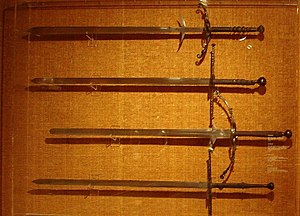Zweihänder: Difference between revisions
No edit summary |
No edit summary |
||
| Line 41: | Line 41: | ||
}} |
}} |
||
{{Foreignchar|Zweihaender|ä}} |
{{Foreignchar|Zweihaender|ä}} |
||
The {{Audio|De-zweihaender.ogg|'''''Zweihänder'''''}} ([[German language|German]] for “two hander”, also called '''Bidenhänder''' or '''Bihänder'''), is a [[two-handed sword]] primarily of the [[Renaissance]]. The weapon is often called, in the [[Western martial arts]] community, a '''[[Greatsword]]''' |
The {{Audio|De-zweihaender.ogg|'''''Zweihänder'''''}} ([[German language|German]] for “two hander”, also called '''Bidenhänder''' or '''Bihänder'''), is a [[two-handed sword]] primarily of the [[Renaissance]]. The weapon is often called, in the [[Western martial arts]] community, a '''[[Greatsword]]'''. |
||
While implemented in [[Germany]] in the 14<sup>th</sup> century{{Citation needed|date=February 2007}}, it gained renown during the 16<sup>th</sup> century as the hallmark weapon of the German [[Landsknecht]]s from the time of [[Maximilian I, Holy Roman Emperor|Maximilian I]]. They were allegedly used by the front lines of the Landsknecht, where they would be used to hew through the opposing [[pikemen]] and spearmen whose spears presented a difficult barrier for normal weapons and [[cavalry]]. |
While implemented in [[Germany]] in the 14<sup>th</sup> century{{Citation needed|date=February 2007}}, it gained renown during the 16<sup>th</sup> century as the hallmark weapon of the German [[Landsknecht]]s from the time of [[Maximilian I, Holy Roman Emperor|Maximilian I]]. They were allegedly used by the front lines of the Landsknecht, where they would be used to hew through the opposing [[pikemen]] and spearmen whose spears presented a difficult barrier for normal weapons and [[cavalry]]. |
||
Revision as of 17:16, 3 May 2011
| Zweihänder | |
|---|---|
 Zweihänders with and without Parierhaken | |
| Type | Sword |
| Service history | |
| In service | ca. 1300 - 1700 |
| Specifications | |
| Mass | 2 - 3.2 kg |
| Length | up to 180 cm |
| Blade type | Double-edged, straight bladed |
| Hilt type | Two-handed cruciform, with pommel |
Template:Foreignchar The (German for “two hander”, also called Bidenhänder or Bihänder), is a two-handed sword primarily of the Renaissance. The weapon is often called, in the Western martial arts community, a Greatsword.
While implemented in Germany in the 14th century[citation needed], it gained renown during the 16th century as the hallmark weapon of the German Landsknechts from the time of Maximilian I. They were allegedly used by the front lines of the Landsknecht, where they would be used to hew through the opposing pikemen and spearmen whose spears presented a difficult barrier for normal weapons and cavalry.
Perhaps the best known user of a Zweihänder was Pier Gerlofs Donia who is reputed to have wielded it with such skill, strength and efficiency that he managed to behead multiple people with it in a single blow. The Zweihänder ascribed to him is, as of 2008, on display in the Frisian museum. It has a length of 213 cm (84 in) and a weight of about 6.6 kg (14½ lb).[1]
Technical Features
The Zweihänder could be up to 180 cm (6 ft) long from the base of the pommel to the tip of the blade, with a 120–150 cm (4–5 ft) blade and 30–45 cm (1–1½ ft) hilt. The weight could range between 2 kg and 3.2 kg (4½–7 lb). However, a ceremonial Zweihänder, which was unsuitable for combat, could weigh up to 7 kg (16 lb).
Some were shorter, though. Earlier versions, in particular, often had an overall length of about 150 cm (5 ft), weighing as little as 1½ kg (3 lb 5 oz).
Features
Guards could be plain or ornate, while hilts usually ended with heart or pear shaped heavy pommels. Occasionally a blunted portion of the forte, the ricasso or Fehlschärfe (meaning “missing sharpness”) at the base of the blade allowed a hand to be placed below the lower guard to “shorten the grip” and make the handle like a polearm. This allowed the user to crudely repel a cavalry charge. The swords have hilt-mounted side-rings and enlarged cross-guards of up to 35 cm (14 in) across. Along the blade, some 10–20 cm (4–8 in) from the upper guard, Parierhaken (“parrying hooks”) shaped like lugs or flanges acted as a guard for the ricasso to prevent other weapons from sliding down the blade.
Application

According to post-medieval accounts, the earlier, more practical Zweihänder types were used to break up pike formations, first by smashing the pikes and then by hitting the pikemen themselves.[citation needed].
Some scholars [who?] suggest that this is a latter-day legend, and that the type was mainly used for display. But at least as a legend, the notion appears to date to at least the 17th, if not the late 16th century. A fanciful depiction of a Zweihänder used against a halberd in a battle line appears in a Polish chronicle dated to 1597.
Soldiers trained in the use of the sword (the title Meister des langen Schwertes was granted by the Marx brotherhood) earned twice the pay of a common footman and were called Doppelsöldner (“double mercenary”). The Doppelsöldner were often used as guards of artillery batteries.
The “Goliath Fechtbuch” (1510) [2] shows fencing with Zweihänder-sized swords, albeit without the parrying hooks. This creates some debate as to whether or not Zweihänders are in fact being depicted. The swords are depicted being used in a manner similar to longswords. Though the point might be considered moot, given the fact that both longswords and Zweihänder used the same fencing style, modified to account for the Zweihänder's greater size.
A skillful Zweihänder user could easily decapitate and dismember enemy pikemen.[citation needed] The Zweihänder could also be used for half-swording due to the make-shift second handle on the ricasso.
References
External links
- Essay by Anthony Shore (Journal of Western Martial Art)
- The Weighty Issue of Two-Handed Greatswords, by John Clements
